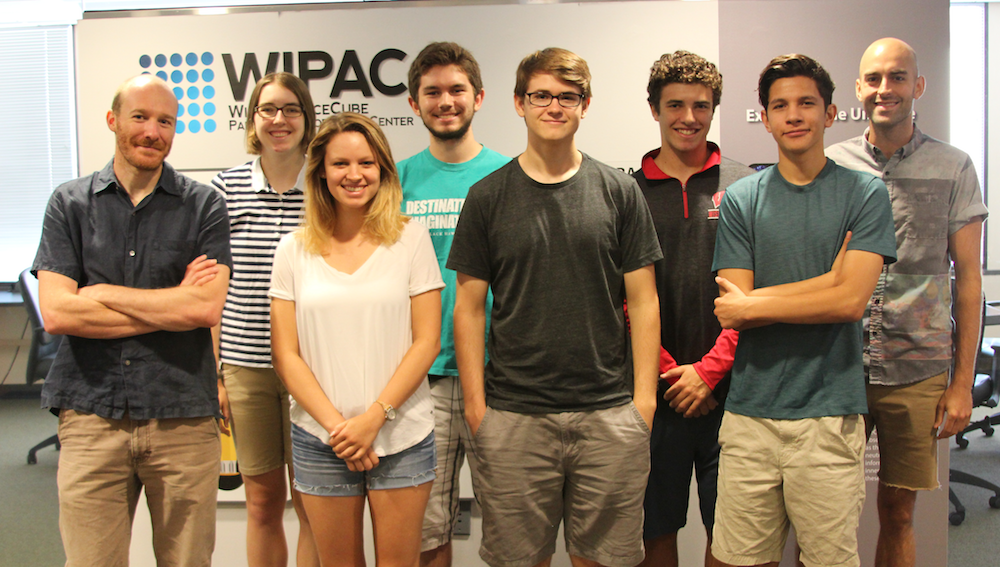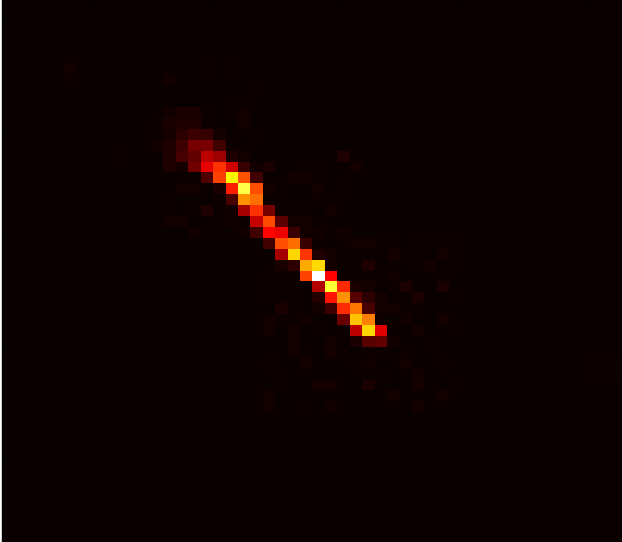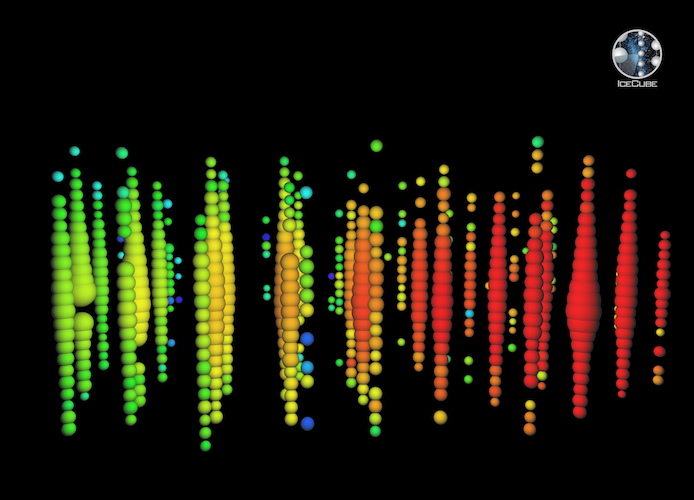Like in musical chairs, people should be very careful with their office chair at WIPAC during the summer. Researchers are in and out for conferences—and some vacation, too, visitors from abroad come for a few weeks, and new graduate students join the team for years to come. And, as if this were not hectic enough, in come five high school students and a teacher, ready to work on DECO and IceCube for the summer.
The 2016 WIPAC-QuarkNet internship hosted students from Madison, Cottage Grove, and Janesville, Wisconsin, and even one from Glen Allen, Virginia. Jeff Leider, a high school teacher in Janesville, and WIPAC mentors Justin, Matt, Colin, Cassidy and Sílvia had high expectations for this group of students selected from over 50 applicants for the second edition of the summer internship. But these teens far exceeded them!

“I applied to WIPAC because I had taken my first physics course recently, and really loved it. I thought that it would be really great to to be involved in real-world, modern physics research,” says Owen Roszkowski, a senior at West High School in Madison. “It turned out to be exactly what I had hoped, and I was able to learn all about advanced topics relating to neutrinos and their effect on our understanding of the world.”
“I was thrilled when I found out I got accepted as an intern and immediately shared the news with all of my friends and family,” explains Valerie Hellmer, also a senior at West High School. “However, I also felt slightly nervous since I did not know what to expect going into my first day at the office. But after our first meeting, where I learned more about the fascinating work we would undertake this summer, I was ready to start my project as soon as possible,” adds Valerie
The projects were all exciting from the physics perspective and involved developing new skills in programming, math, teamwork, and communications. Mykalin Jones (MJ), an undergraduate student at Worcester Polytechnic Institute and a UW-River Falls REU student this summer, also joined the internship remotely.
Two students worked on IceCube and designed citizen science projects that will soon invite people around the world to examine IceCube data and help improve computer-based algorithms used in important searches for astrophysical neutrinos or in neutrino physics studies.
The other four students worked on DECO, the app that turns your cell phone into a particle detector, and designed new tools to identify cosmic-ray signatures in data collected by mobile devices in every corner of the Earth, including Antarctica and in the middle of the ocean, see map here. One of the students also continued the development of the DECO iOS app.
|
|
|
Tyler Dolan is a senior at Monona Grove High School. He was very excited when he learned he would be one of the interns. “And the excitement stayed for the whole internship. The first week, it was all about joining a research lab. The second week, it was about becoming a team member. And from then on, you know, real research. Addressing questions that might not have an answer.”
But as Felipe Campos, a senior at Collegiate School in Richmond, VA, describes the internship, it’s not only about research. “Over the course of the internship—which so happened to unify two of my favorite topics: physics and computer programming—I learned countless new skills and improved on several old ones. The unique experience of developing DECO for the iOS platform required me to both use and improvise on my knowledge of computer programming and mobile app development in parallel with my understanding of the physics behind the app in order to develop software functioning at its full potential.”
The summer internship aims to provide an authentic experience on how a multidisciplinary and international research team works. Students and mentors met every Monday to discuss progress on each project and define goals for the week. Each student had a specific project to work on his/her own, but they were all expected to contribute to every project with their expertise in programming and data analysis and by checking tools and content as they were developed. At the end of the internship, students presented their work to the entire WIPAC community and answered questions from researchers, students, and even some guests.
“There was definitely an emphasis on teamwork. The environment was very welcoming, and we were made to feel as equals working on a team, as opposed to students following behind instructors,” explains Adrian Cisneros, a junior at Milton High School. “We worked together, covering new ground together and progressing as a unit, and I think that was really very conducive to my growth as an individual on the team.”
Many of the concepts and work culture were also new to Jeff, who explains that this was a very enriching experience for him both as a teacher and a person interested in science. “This summer really opened my eyes to the particle astrophysics field. I’ll continue to encourage kids to apply for your fall internships and masterclass in the spring.”
 |
 |
 |
 |
Overall, the internship required a lot of effort, both from students and the teacher and from mentors. But, everyone felt proud of the students and the work they accomplished.
“The beginning of the internship was daunting because of the immense amount of ground to cover in six weeks. However, the creativity and energy the students brought every day made the job easy,” comments Matthew Meehan, a graduate student at WIPAC. “I was invigorated by their enthusiasm and tried to focus it on a few of the myriad ideas they had for the projects. I was impressed by the tremendous progress they made over the course of the internship; they learned and produced useful scientific results.”
“I was glad that I got to be a part of the WIPAC high school internship. As a student in Naperville, Illinois, I got to participate in a QuarkNet program through Fermilab and the University of Illinois at Chicago, building and using muon detectors. One of my mentors from Fermilab actually recommended me for the research position I have now at WIPAC, which shows that making these types of connections early on can lead to many more opportunities down the road!” says Cassidy Schneider, an undergraduate student at UW–Madison also doing research at WIPAC.
Another UW–Madison undergraduate student, Colin Adams, also helped mentor the interns. “It’s great to be able to help provide such a unique learning opportunity to these students. A lot of the skills they developed this summer aren’t really taught in high school but are incredibly advantageous to have. I hope that everything they learned with us will stick with them long after this program ends.”
As the saying goes, it takes a village to raise a researcher, and being an active member of the village is also what one expects from a scientist.
“The students were full of ideas and developed into a great team, working well with one another and their mentors. It was easy to forget that they are still high school students!” explains Justin Vandenbroucke, a physics assistant professor at UW–Madison and the principal investigator of the DECO project.
Adrian, Felipe, MJ, Owen, Tyler and Valerie, thank you and congratulations for your great work this summer!
This internship was supported by the UW–Madison QuarkNet Center hosted at WIPAC. This program aims to develop innovative and genuine astrophysics research experiences for high school teachers and students.


